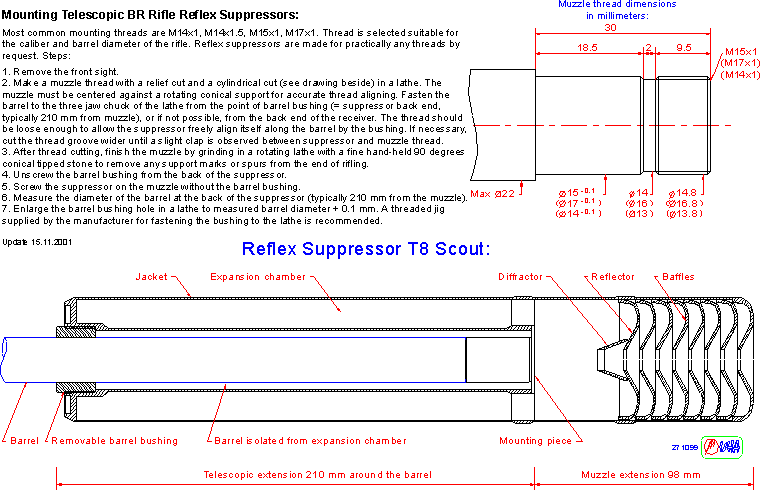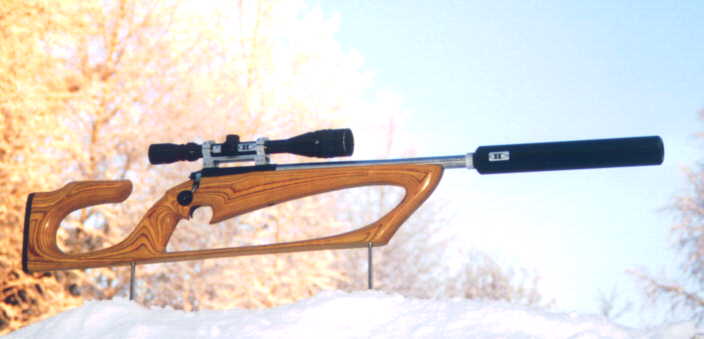
Telescopic Reflex Suppressor T8 Scout


Telescopic Reflex Suppressor T8
Scout

The rifle caliber telescopic Reflex Suppressor is a device developed for
hearing protection for full power cartridges. It diminishes superbly the environmental
noise attacks and risks of hearing deterioration. The T8 Scout suppressor is
today the world’s most produced rifle suppressor. For the shooter its noise-killing
effect equals best hearing muffs. T8 Scout and its shorter version T4 Ranger are
the most widely used suppressors for hunting and accuracy rifles. The hunters as well as
their dogs are efficiently safeguarded against hearing losses.
Construction: Because of it's telescopic layout most of the suppressor
body is behind the muzzle, and the suppressor supports itself from two points around the
barrel. Disconnectable barrel bushing at the back of the suppressor enables using the same
suppressor on separate rifles with barrel diameters up to 22.5 mm. Telescopic mounting
makes a very rigid mounting, and a Telescopic Reflex Suppressor withstands shooting even a
few turns loose, which will regularly damage traditional forward mounting suppressors.
Reflex Suppressor is a wipeless design, so it does not reduce bullet velocity. Because of
its sturdy construction it can be used also as wet. For details about wet suppressor
techniques and absorbing substances see Alan C. Paulson's book: Silencer History and Performance, volume 1 (Paladdin Press).
Dimensions and calibers: Telescopic Reflex Suppressors outside diameter
is 50.5 mm (2"). They come in two standard lengths: T4 Ranger with four
suppressing baffles extends the rifle by only 60 mm or 2 1/2". Short T4 Ranger is
commonly used in .223 rifle caliber class. Longer T8 Scout with eight baffles
extends the rifle by 98 mm or less than 4", and it is commonly used in .308 or
heavier calibers. A special reinforced model T8M is for magnum rifle calibers.
Reflex Suppressors are available with four different bullet hole diameters in baffles, the
largest being for .458 Magnum. Separate larger Reflex Suppressor models are available for
some .50 BMG rifles.
Performance: The T8 Scout drops the peak noise level of full-power .308
Win cartridges typically from 157 dB down to 135 dB, which is clearly under the
recommended max. peak level in EC and US standards of 140 dB and one of the very lowest
shooter's noise levels measured with .308 high velocity ammunition. Please remark that the
risks of hearing injuries are not totally avoided even below the 140 dB risk level if one
is shooting in indoor ranges prone to echoing or firing hundreds of shots weekly. Combined
use of hearing protectors and a suppressor is recommended whenever that is possible
because only then centerfire rifle noise levels are dropped considerably below the noise
level of a .22 rifle that can be regarded as almost riskless.
Bullet noise: When using a suppressor with normal high velocity
ammunition the sound in front of the weapon is not removed, but the noise towards the
shooter is brought down enough to be considered safe for occasional shooting with
unprotected hearing. Thus in hunting circumstances the game hears the shot and escapes the
shooter like with unsuppressed weapons. The noise in front of a suppressed firearm is due
to the fact that the noise of a bullet exceeding the speed of
sound (sonic barrier or Mach 1) cannot be removed with any suppressor. Only bullets
traveling slower than the speed of sound (bullet velocity abt. 300 m/s), known as
”subsonics” will remove that noise. However, subsonics have far too low energy
level for practical hunting and they are not even allowed for hunting in most countries.
Their range is also very short, as the trajectory becomes very curved after 50 meters. If
using subsonic cartridges please also pay attention to adequate rifling twist declared in
chapter ”Rifling twist with subsonic ammo” (below).
Accuracy: When properly mounted, a suppressor usually does not increase
spread of impacts. Instead, it may even tighten the group. Additional weight on the barrel
shifts the place of the group center, but that displacement is easily corrected by aiming
off. Extent of displacement is usually less than one MIL or four Minutes Of Angle (<10
centimeters at 100 meters), depending on type of rifle and ammo. More extensive off-aiming
or sight adjustment may be needed when using subsonic cartridges because of their slow
initial velocity and curved trajectory. With self-loading rifles low powered subsonics are
usually unable to eject and feed. If mechanical noise of action is to be avoided, it is
advisable to keep possible gas port valve closed even when shooting with full-power
cartridges.
Rifling twist with subsonic ammo: Using custom-loaded 7.62 x 51 mm /.308
subsonic rounds (muzzle velocity ca. 300 m/s or 1000 fps) the noise of the shot is not
very much louder than the sound of a firing hitting an empty chamber. However, these
loadings require a 254 mm or 10" twist of rifling to stabilize heavier bullets than
9.7 g or 150 gr. in .30 caliber class. Lighter bullets will be stabilized also in 305 mm
or 12" twist. Do not shoot with unstable ammo, because they may graze or even damage
the baffles of a suppressor!
Tightening the suppressor on muzzle: When
winding the Telescopic Reflex Suppressor on your rifle tighten it only moderately. It is
advisable to use only as much force as realized with fingertips of one hand. Do
not overtighten! Overtightening may result to excess shift of group or loss of
accuracy. It is a good habit to tighten the suppressor always and repeatedly to same
finger felt tightness to ensure optimum accuracy and to keep the same point of aim.
Maintenance: Reflex Suppressor is a practically maintenance-free device.
Normal fouling from powder and primers do not have effect on its functioning. Loose solid
impurities like powder grains and carbon chips are easy to remove by shaking the
suppressor, while keeping it vertically, front end downwards. Compressed air may be used
for cleaning and gun oil for preserving, but washing with liquids or solvents is
unadvisable. Remove the suppressor or leave the action of the rifle open after a shooting
session. This helps to avoid corrosion by letting steam condensation from powder gas to
evaporate away.
Please observe: It is to be emphasized that protecting the hearing
depends on everyone’s own precautions and activity; suppressors offer means to
diminish the risks of hearing damage. The manufacturer cannot be held responsible in any
event or circumstances for any hearing injuries as the possibility to have control over
the use of product does not exist. Appropriately mounted suppressor, when used according
to normal shooting and gun handling precautions, delivers noise attenuation that helps
bring down risks of hearing injuries.
Muzzle brake effect: Reflex Suppressor is a highly efficient muzzle
brake, due to abrupt reflection or blowback of muzzle blast in the first expansion
chamber. The threading for a suppressor also serves for mounting a separate muzzle brake.
Attention! The devices serving only as muzzle brakes are not recommended, as they increase
essentially the shooter's noise level! The peak noise level to shooter may go up from abt.
157 dB to up to abt.167 dB with a .308 Win rifle if equipped with a muzzle brake. Such a
noise level can cause permanent damage to unprotected hearing even with single shots!
Mounting is made by the manufacturer or by a competent gunsmith. As the
suppressor extends telescopically backwards from the muzzle and around the barrel, the
front sight must be removed. A M15x1, M17x1 or M14x1 thread with centering sleeve is cut
on the muzzle in a lathe; for details see separate mounting instruction. Other threads are
available by request. Telescopic suppressors do not mount to guns having a long tubular
magazine or full stock. In such cases, the forward mounting Reflex Suppressor R12 or KRS may be used.
Warning:
- Do not shoot shotshells, unstable projectiles or discarding sabot bullets through a
suppressor, as they may damage it.
- With self-loading rifles all suppressors tend to increase powder gas blowback through
the action opening after the shot. With rifles having this tendency, use shooting goggles
to prevent powder particles getting in your eyes.
The Reflex Suppressor T4 Ranger or T8 Scout accessories:
- Standard: A thread shield nut for M15x1, M17x1 or M14x1 muzzle thread for unsuppressed
use of the rifle.
- By request: If mounting is not done by manufacturer, a jig for centering the barrel
bushing nut in a three-jaw chuck of a lathe, to enlarge the bushing aperture to barrel
diameter.
- By request: Extra barrel bushings for mounting one suppressor to separate rifles.
Mounting Instructions

Click to enlarge drawing!
Reflex
Suppressors for Rifles

Photo of a custom built BR Integral rifle with a Telescopic
Reflex Suppressor.
Rifle Reflex Suppressors on
Internet: http://guns.connect.fi/rs/mounting.html
Index Main
General Rifles
50 BMG SMG
MG AR Contact Links
Measuring License
Manufacturing Lyddemper.net
Suppressors in the UK På svenska